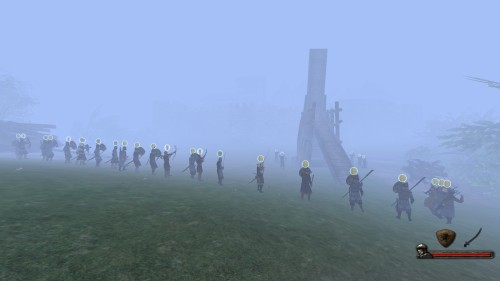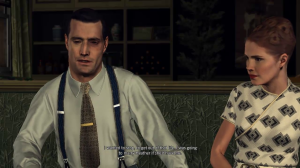This blog post is adapted from the paper I gave at the Textualities 2013 MA Conference on 8 March 2013 at the School of English, University College Cork.
In the Old High German Hildebrandslied, the two warriors Hildebrand and Hadubrand, who are both father and son and the champions of two opposing armies, end up fighting each other. Although the outcome is not stated, it is assumed that the father kills the son. But why did they have to fight in the first place?
The reasons behind the two warrior’s actions can be found in the heroic ideal prevalent in Germanic societies up to the Middle Ages. Among the virtues propagated in this ideal are seeking of lasting fame, loyalty and stoic acceptance of fate. The aspect that is most problematic in the Hildebrandslied is loyalty. In the text, there is a clash between loyalty to a lord and loyalty to relatives. A lord gathered many retainers around himself who would protect him and whom he would protect. In exchange for their loyalty, he would give them treasures such as gold or rings (O’Brien O’Keefe 107f.).
The Hildebrandslied makes clear that both Hildebrand and Hadubrand are bound to a lord. When Hildebrand wants to make peace, he offers his son an armring “cheisuringu gitan, so imo se der chuning gap” (“made from the emperor’s gold, which the king had given to him”, Hildebrandslied 34). The king gave him treasures, and it is Hildebrand’s duty to fight for him in battle. Further on in the conversation, Hildebrand remarks about Hadubrand’s armour from which he concludes that Hadubrand has a good lord. This connection between the quality of armour and a chief can only mean that Hildebrand thinks it is a gift to Hadubrand from a lord. Thus, both warriors have vowed loyalty to some kind of leader, and their armies are present to witness that this promise is not neglected.
Fighting for the lord in a battle was a retainer’s duty. In the case of Hildebrand, however, it is not as simple as that. Fate has forced him to fight against and kill his own and only son. The family bond was as important as loyalty to a lord. Protection of kinspeople and vengeance for killed family members were imperative aspects of the hero’s life in heroic lays and epics . Killing your own kin was deemed unnatural and shameful (Bostock 60). Hildebrand realises exactly this conflict when he complains that “nu scal mih suasat chind suertu hauwan, breton mit sinu billiu, eddo ih imo ti banin werdan” (“Now shall my own child hit me with his sword, strike with his blade, or I will slay him”, Hildebrandslied 53-4). Referring to this passage, Siegfried Gutenbrunner concludes that “hier wird also die Hildebrand-Hadubrand-Thematik sichtbar, der Zwist, der zwischen denen droht, die untrennbar zusammenhalten sollten” (“here, the Hildebrand-Hadubrand-theme comes to the fore, the dispute between those who should cling together”, Gutenbrunner 141). This describes precisely the problem at the core of the poem: a fight between two people closely related that cannot be averted.
From Hadubrand’s perspective, the situation is simple. He never realises Hildebrand is his father. He perceives the other warrior to be a “clever old hun” (Hildebrandslied 39) and only has to follow the loyalty to his lord. In the words of Gutenbrunner: “Er glaubt sich und sein Land in der Gefahr einer hunnischen Invasion und stürzt sich in die Gefahr, das Friedensangebot Hildebrands mißachtend, mißdeutend, verachtend” (“he thinks himself and his country in danger of a Hunnish invasion and decides to fight, ignoring, misinterpreting and condemning Hildebrand’s peace-offering”, Gutenbrunner 44). Hildebrand, on the other hand, is trapped between disloyalty to his king and disloyalty to his family. If he decides to kill his son, his family line will die; if he decides not to fight against his son, his side will lose the battle, he will lose his reputation and will be forced to live a life in shame. He opts for the duties to his lord, as it is the only possibility in the set of values that form the heroic code.
Hence, the chief conflict of the text is one of irreconcilable loyalties. Hildebrand was forced to fight against his will by the principles that guide his life as a warrior, he is, to quote Brian Murdoch, “subordinate to a code which he has accepted already in general terms” (Murdoch 58). It turns out that the battle was indeed inevitable. By making this conflict the focus of a lay, however, the poet also makes his audience aware of this problem inherent in the heroic ideal. He stresses that there are contrasting values at work that can and will lead to grave consequences, such as a father being forced to kill his son because there simply is no possible alternative.
References:
Bostock, J. Knight. A Handbook on Old High German Literature. Oxford: OUP, 1976. Print.
Gutenbrunner, Siegfried. Von Hildebrand und Hadubrand: Lied, Sage, Mythos. Heidelberg: Winter, 1976. Print.
“Hildebrandslied.” Althochdeutsches Lesebuch. Ed. Wilhelm Braune. Tübingen: Niemeyer, 1994. Web. <http://www.linguistics.ruhr-uni-bochum.de/~strunk/Deutsch/hildebra.htm>.
Murdoch, Brian. The Germanic Hero: Politics and Pragmatism in Early Medieval Poetry. London: Hambledon Press, 1996. Print.
O’Brien O’Keefe, Katherine. “Heroic Values and Christian Ethics.” The Cambridge Companion to Old English Literature. Ed. Malcolm Godden and Michael Lapidge. 107- 25. Cambridge: CUP, 1991. Print.







